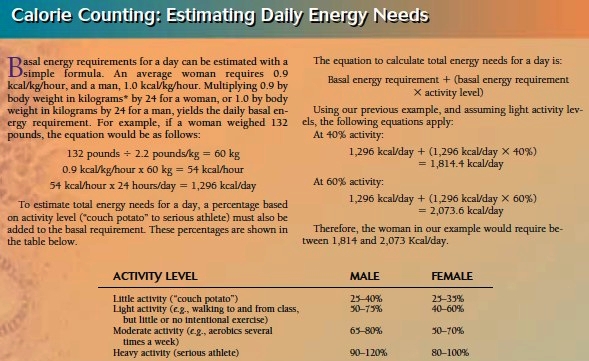Metabolism
Nutrients absorbed from the digestive tract are used for all the cellular activities of the body, which together make up metabolism. These activities fall into two categories:
* Catabolism, which is the breakdown of complex compounds into simpler compounds. Catabolism includes the digestion of food into small molecules and the release of energy from these molecules within the cell.
* Anabolism, which is the building of simple compounds into substances needed for cellular activities and for the growth and repair of tissues. Through the steps of catabolism and anabolism, there is a constant turnover of body materials as energy is consumed, cells function and grow, and waste products are generated.
Cellular Respiration
Energy is released from nutrients in a series of reactions called cellular respiration Fig. 16-1. Early studies on cellular respiration were done with glucose as the starting compound. Glucose is a simple sugar that is the main energy source for the body.
The Anaerobic Phase The first steps in the breakdown of glucose do not require oxygen; that is, they are anaerobic. This phase of catabolism, known as glycolysis, occurs in the cytoplasm of the cell. It yields a small amount of energy, which is used to make ATP (adenosine triphosphate), the cells’ energy compound. Each glucose molecule yields enough energy by this process to produce 2 molecules of ATP. The anaerobic breakdown of glucose is incomplete and ends with formation of an organic product called pyruvic acid. This organic acid is further metabolized in the next phase of cellular respiration, which requires oxygen. In muscle cells operating briefly under anaerobic conditions, pyruvic acid is converted to lactic acid, which accumulates as the cells build up an oxygen debt. Lactic acid induces muscle fatigue, so the body is forced to rest and recover. During the recovery phase immediately after exercise, breathing restores the oxygen needed to convert lactic acid back to pyruvic acid, which is then metabolized further. During this recovery phase, reserves stored in muscles are also replenished. These compounds are myoglobin, which stores oxygen; glycogen, which can be broken down for glucose; and creatine phosphate, which stores energy.
The Aerobic Phase To generate enough energy for survival, the body’s cells must break pyruvic acid down more completely in the second phase of cellular respiration, which requires oxygen. These aerobic reactions occur within the mitochondria of the cell. They result in transfer of most of the energy remaining in the nutrients to ATP. On average, about 34 to 36 molecules of ATP can be formed aerobically per glucose molecule quite an increase over anaerobic metabolism. During the aerobic steps of cellular respiration, the cells form carbon dioxide, which then must be transported to the lungs for elimination. In addition, water is formed by the combination of oxygen with the hydrogen that is removed from nutrient molecules. Because of the type of chemical reactions involved, and because oxygen is used in the final steps, cellular respiration is described as an oxidation of nutrients. Note that enzymes are required as catalysts in all the reactions of cellular respiration. Many of the vitamins and minerals described later are parts of these enzymes.
The Aerobic Phase To generate enough energy for survival, the body’s cells must break pyruvic acid down more completely in the second phase of cellular respiration, which requires oxygen. These aerobic reactions occur within the mitochondria of the cell. They result in transfer of most of the energy remaining in the nutrients to ATP. On average, about 34 to 36 molecules of ATP can be formed aerobically per glucose molecule quite an increase over anaerobic metabolism. During the aerobic steps of cellular respiration, the cells form carbon dioxide, which then must be transported to the lungs for elimination. In addition, water is formed by the combination of oxygen with the hydrogen that is removed from nutrient molecules. Because of the type of chemical reactions involved, and because oxygen is used in the final steps, cellular respiration is described as an oxidation of nutrients. Note that enzymes are required as catalysts in all the reactions of cellular respiration. Many of the vitamins and minerals described later are parts of these enzymes.
Figure 16-1 Cellular respiration. This diagram shows the catabolism of glucose without oxygen (anaerobic) and with oxygen (aerobic). (C = carbon atoms in one molecule of a substance.) In cellular respiration, glucose first yields two molecules of pyruvic acid, which will convert to lactic acid under anaerobic conditions, as during intense exercise. (Lactic acid must eventually be converted back to pyruvic acid.) Typically, however, pyruvic acid is broken down aerobically (using oxygen) to CO2 and H2O (aerobically).
Although the oxidation of food is often compared to the burning of fuel, this comparison is inaccurate. Burning fuel results in a sudden and often wasteful release of energy in the form of heat and light. In contrast, metabolic oxidation occurs in small steps, and much of the energy released is stored as ATP for later use by the cells; some of the energy is released as heat, which is used to maintain body temperature. For those who know how to read chemical equations, the net balanced equation for cellular respiration, starting with glucose, is as follows:


Metabolic Rate Metabolic rate refers to the rate at which energy is released from nutrients in the cells. It is affected by a person’s size, body fat, sex, age, activity, and hormones, especially thyroid hormone (thyroxine). Metabolic rate is high in children and adolescents and decreases with age. Basal metabolism is the amount of energy needed to maintain life functions while the body is at rest. The unit used to measure energy is the kilocalorie (kcal), which is the amount of heat needed to raise 1 kilogram of water 1° C. To estimate the daily calories needed taking activity level into account.

Contacts: lubopitno_bg@abv.bg www.encyclopedia.lubopitko-bg.com Corporation. All rights reserved.
DON'T FORGET - KNOWLEDGE IS EVERYTHING!